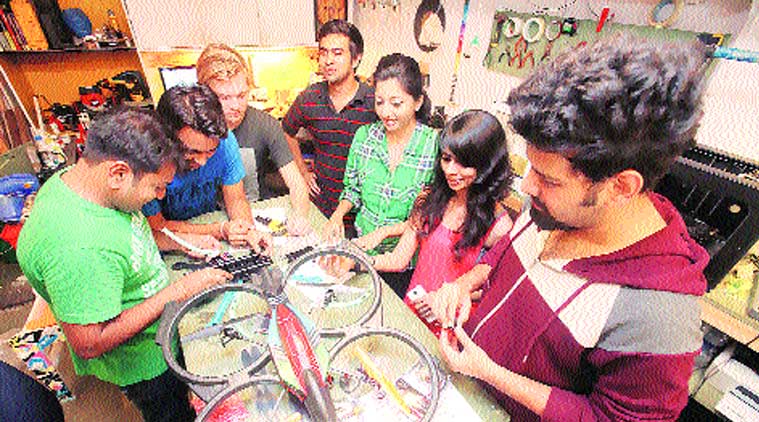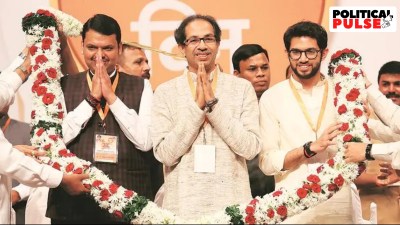- India
- International
Tinker, Tailor, Solder, Pi
The maker community across the country is experimenting in hardware, with dedicated spaces for hobbyists
 (Source: Ardubotics)
(Source: Ardubotics)
If someone told you ink could sing, would you believe them? You would, if you saw how designs can emit sounds. At the UnBox Festival held in Delhi over the weekend, Himanshi Bablani collaborated with Justin Marshall, professor from the University of Falmouth, UK, at the Digital Craft workshop. “We used the conductive ink (ink that conducts electricity) and touch board. The participants made patterns on paper with wooden blocks used for block printing. The prints were connected to the touch board, which was programmed to make these prints into capacitive touch surfaces. When someone touched one of these prints, it triggered a sound that was recorded at the festival, which was stored in a memory card on the touch board,” he says. Bablani, an entrepreneur and part of Delhi Makers, is one of the many who are go-karting the maker community in the country.
In Mumbai, the Maker’s Asylum is a 300 sq ft basement space in Bandra, created for the maker community, a subculture of people who have a DIY approach to innovation. A shared interest in DIY had Vaibhav Chhabra and Kirti Shetty invest in this space in November last year. “We wanted to start a community where people would come and build stuff in the evenings and on weekends,” says Chhabra. Today, Maker’s Asylum is frequented by engineers, architects, designers and others curious to learn and create. Much of the maker culture in India was fostered on social media groups such as Maker Space Chennai and Internet of Things, but there’s been a lack of dedicated physical spaces. That is now changing.
Bangalore-based Pavan Kumar began Workbench Projects with Anupama Prakash in June this year. Akin to Maker’s Asylum, the facility, set up in a 5,000 sq ft space, stocks DIY tools, prototyping machines and holds workshops, with a focus on responsible innovation. “It’s an incubation space for ideas,” says Kumar, “It’s not just tech. We’ve had others on organic terrace gardening and basic maintenance of bicycles.”
Delhi Makers too conducts similar workshops, which recently included cardboard chair making. “We have designers and enthusiasts of different age-groups from 26-30. In our urban gardening workshop, we had couple of senior citizens too, who had kitchen gardens. Some made raised gardens, while others had hanging ones,” says Bablani. A six-member group, the Delhi Makers will have a 1,500 sq ft space near the Qutub metro station next month, which will facilitate the community to come together to tinker, experiment and make products that interest them.
There are other makers like Atul Yadav of Heramb Maker Lab who are taking the movement forward, with a new space in Pimpri, Pune. “Doing something by hand always pushes people to think differently,” he says.

The maker community is also now getting off social media pages and meeting each other. Earlier this year, India saw a gathering of 80 innovators from across India who showcased their inventions at the first Maker Fest at National Institute of Design in Ahmedabad. The two-day event introduced 8,000 people who attended the fest to Google glass, indigenous arts and crafts, 3D printers, programmable mini-computers such as Arduinos and Raspberry Pis, among other innovations.
An extension of the Maker Faire, which is held across the world, is the brainchild of California-based venture capitalist Asha Jadeja. “I was inspired by the effect Maker Faire California had on my children. I decided to fund an entrepreneur, who wanted to take Maker Faire to Africa. There, I witnessed the transformative impact of giving a platform to local innovators, garage tinkerers, who have other full-time jobs,” says Jadeja. The second edition of the festival is on January 10-11, 2015 in Ahmedabad.
In a country known for jugaad, the challenges to the maker movement are many, including funds and the dearth of practical learning in schools. Says Chhabra, “The focus has always been towards software. When people start considering hardware cool, creating will come easily.”
Inputs by Shiny Varghese
Apr 20: Latest News
- 01
- 02
- 03
- 04
- 05






































